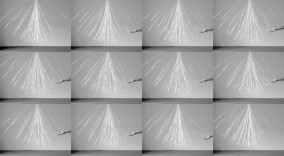Mendy
Video
The rise of information theory in the 1950s, especially its emphasis on the transmission of messages, placed a new focus on the listener, outlining a theory of reception that the artistic styles of the 1960s (kinetic and concrete art, as well as conceptual art on the other hand) responded to, by showing a new interest in the role of the audience as an active participant.(1) The works of art no longer bore the mystified mark of the artist’s touch. Kinetic works resembled design objects, and rejected the individual expression, as well as art as an elitist practice. Instead these works favored a collective experience.(2) Conceptual art was not about the refusal of visuality, “[…] but [focused] on something that makes the distinction between visual and non-visual parameters virtually irrelevant: the primacy of information.” (3) Though Mendy is not a conceptual piece in the traditional way, it is created as an aesthetic medium, serving to visualize information: The idea of electricity and the proof of its existence, respectively. Further, Mendy involves the viewer as an active participant: ‘reacting to’ and ‘in accordance to’, thus enableing a collective experience, independently from the image of the artist as the creator.
Looking at the various elements that constitute the work Mendy (2012), one is under the impression of standing in front of an experimental setup: A Van-De-Graaff generator produces electrostatic high-voltage through friction; a thin tube, filled with saline solution passes the voltage on to a bundle of fine paper strips; the charged strips repel each other and are inclined to pour into the shape of a globe. Depending on the controlled frequency of the voltage flow, the paper strips either sink or rise accordingly in intervals. Thus, the almost uncanny illusion of a fragile, calmly breathing individual is created. Upon approaching Mendy, its gentile tentacles will try to discharge through the viewer, who is grounded: They reach out, seeking to touch, as if curiously investigating their visitor. Once contact has been established, the strips will loose their voltage and sink back down. Though only until they are recharged with enough voltage, do the strips rise again. Mendy silently and peacefully reacts to and interacts with its surrounding environment.
Mendy is the poetic visualization of a natural occurrence – electricity – that is always present, but in itself and without a medium, invisible to us. We are familiar with its function and the results of its usage. But seldom do we witness its nature and character as we do with Mendy. Even though Marshall McLuhan deconstructed mysticism as just ‘tomorrow’s science dreamed today’, Mendy reiterates the notion that there is something mystical and supernatural in the relation- ship between men, science, and art. Almost a happening, Lucas Buschfeld’s work Mendy is a stunning perceptional event: “[…] between a planned concept[s] and free acceptance of what will happen, but will happen according to precise, prearranged formative patterns, which do not negate spontaneity, but give it boundaries and potential directions.”(4) Unlike the immobility of a historically prototype work of art – painting etc. – that is waiting to be seen, Mendy – as the medium of electricity – seemingly makes itself while we watch it.
(written by Laura Henseler)
_______
(1) cf. Gioni, Massimiliano. “Of Ghosts And Machines“ in: Ghosts In The Machine, eds. Massimiliano Gioni, Gary Carrion-Murayari (New York: New Museum, 2012), 8-12, here: 11.
(2) op.cit, 10.
(3) Winkel, Camiel van. During The Exhibition The Gallery Will Be Closed. Contemporary Art And The Paradoxes Of Conceptualism, Amsterdam, 2012, 12.
(4) Eco, Umberto. “Arte Programmata,“ in: Ghosts In The Machine, eds. Massimiliano Gioni, Gary Carrion-Murayari (New York: New Museum, 2012), 239-242, here: 240.


